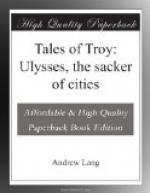The commander-in-chief, as we say now, of the Trojans was Hector, the son of Priam. He was thought a match for any one of the Greeks, and was brave and good. His brothers also were leaders, but Paris preferred to fight from a distance with bow and arrows. He and Pandarus, who dwelt on the slopes of Mount Ida, were the best archers in the Trojan army. The princes usually fought with heavy spears, which they threw at each other, and with swords, leaving archery to the common soldiers who had no armour of bronze. But Teucer, Meriones, and Ulysses were the best archers of the Achaeans. People called Dardanians were led by Aeneas, who was said to be the son of the most beautiful of the goddesses. These, with Sarpedon and Glaucus, were the most famous of the men who fought for Troy.
Troy was a strong town on a hill. Mount Ida lay behind it, and in front was a plain sloping to the sea shore. Through this plain ran two beautiful clear rivers, and there were scattered here and there what you would have taken for steep knolls, but they were really mounds piled up over the ashes of warriors who had died long ago. On these mounds sentinels used to stand and look across the water to give warning if the Greek fleet drew near, for the Trojans had heard that it was on its way. At last the fleet came in view, and the sea was black with ships, the oarsmen pulling with all their might for the honour of being the first to land. The race was won by the ship of the prince Protesilaus, who was first of all to leap on shore, but as he leaped he was struck to the heart by an arrow from the bow of Paris. This must have seemed a good omen to the Trojans, and to the Greeks evil, but we do not hear that the landing was resisted in great force, any more than that of Norman William was, when he invaded England.
The Greeks drew up all their ships on shore, and the men camped in huts built in front of the ships. There was thus a long row of huts with the ships behind them, and in these huts the Greeks lived all through the ten years that the siege of Troy lasted. In these days they do not seem to have understood how to conduct a siege. You would have expected the Greeks to build towers and dig trenches all round Troy, and from the towers watch the roads, so that provisions might not be brought in from the country. This is called “investing” a town, but the Greeks never invested Troy. Perhaps they had not men enough; at all events the place remained open, and cattle could always be driven in to feed the warriors and the women and children.




